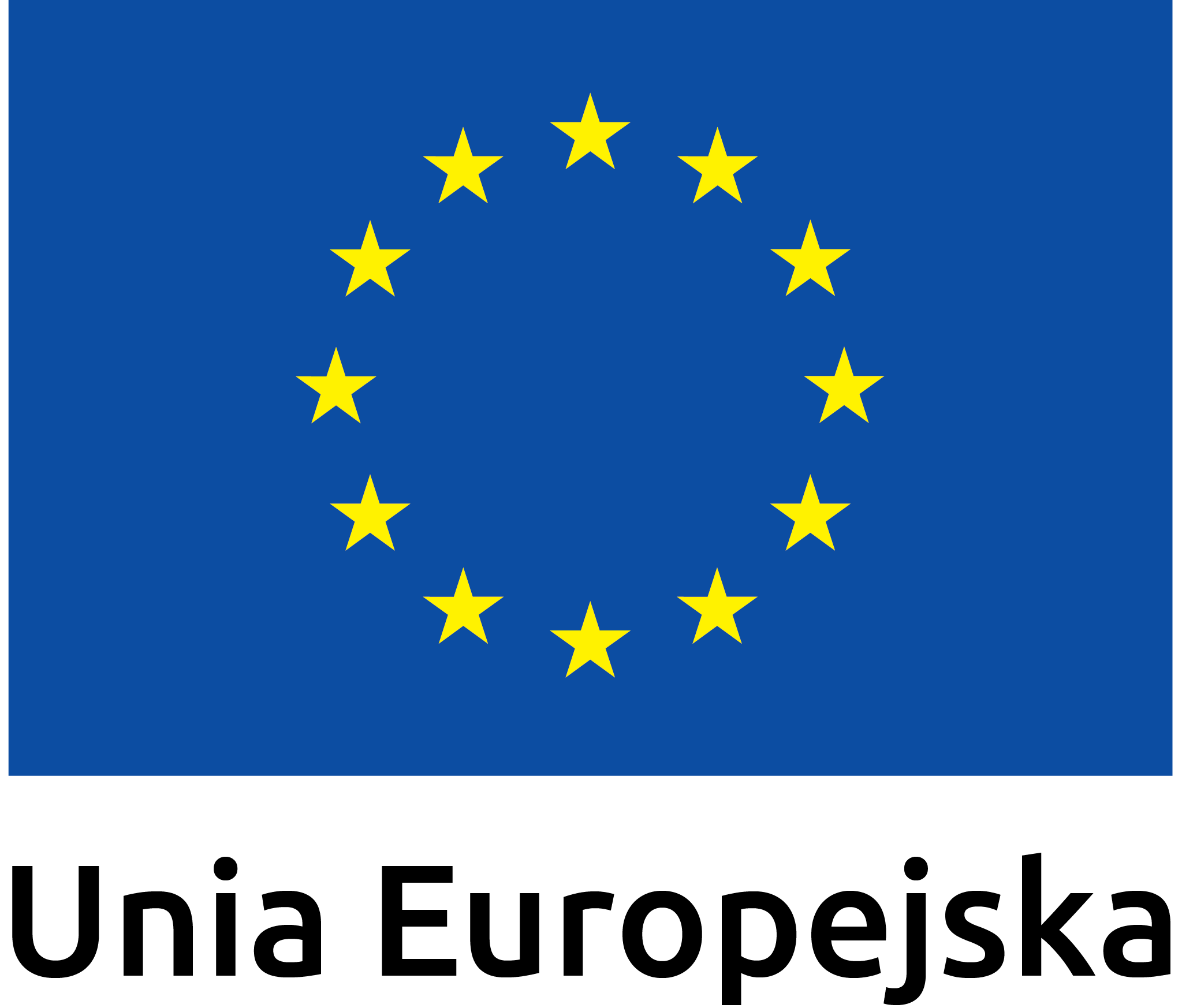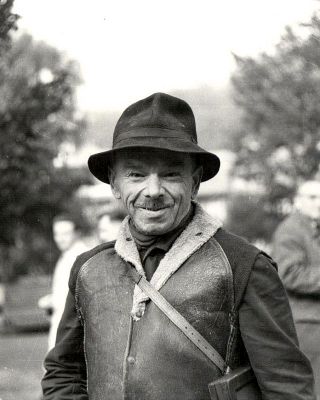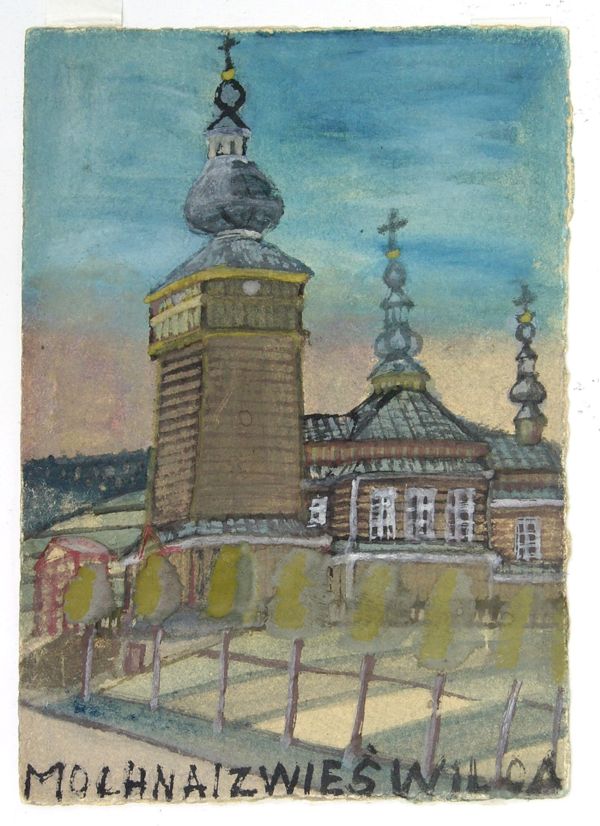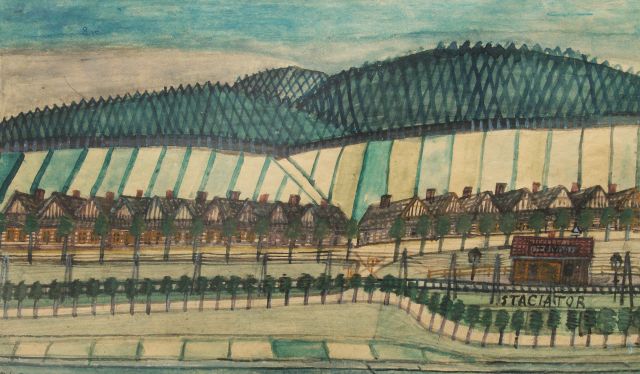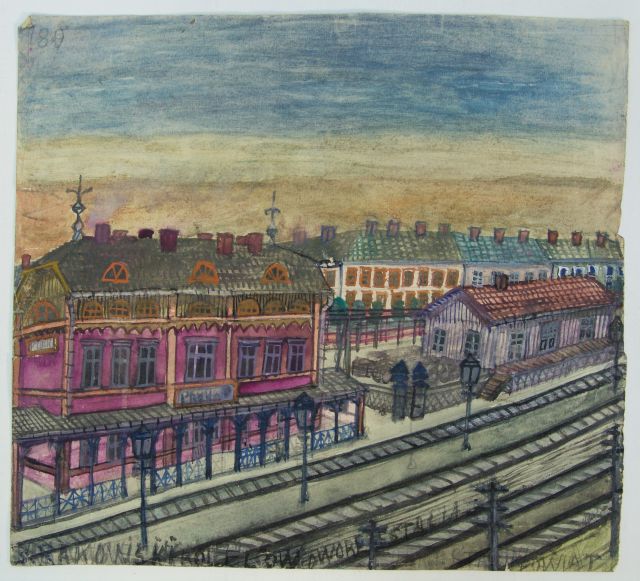Nikifor the painter – Nikifor the artist
Among the people who made the Sądecczyzna region famous, the most extraordinary is undoubtedly the naive painter Nikifor, a Lemko from Krynica Wieś. The artist's real name was probably Epifaniusz Drowniak, but the painter himself signed his paintings with the words "NIKIFOR PAINTER-NIKIFOR ARTIST" and under this name he went down forever in the history of Polish and world art. Nikifor suffered from a hereditary speech impediment, which limited his contact with the environment from childhood. Painting became a better form of communication for him. Before Nikifor's paintings were hung in famous art galleries and found their way into museums and private collections, for decades almost no one in Krynica paid attention to the street painter wandering around the spa every day with a wooden suitcase containing his workshop. He set up his "portable studio" in places where tourists and spa visitors most often walked, offering pictures for sale as "Souvenirs from Krynica". However, few people decided to buy them at that time. There were also those who considered him an ordinary beggar and looked at the colorful pictures as worthless scribbles. Nikifor's "little homeland" was the Lemko region, whose landscapes he expressed in painting in a very personal way. This was brought to the attention of doc. Jerzy Zanoziński, writing about Nikifor's paintings in the catalog for the exhibition at the "Zacheta" in Warsaw in 1967: (...) landscapes from Krynica, or rather the area around Krynica, with motifs of gridded forests, checkerboard fields, tracks and railway stations, painted partly before the war, partly and during the occupation. Landscapes of this type, created by Nikifor with various variations and later, or rather to this day, established his fame as the artist who was the first to notice and in an extremely suggestive way preserve the unique beauty of the landscape of the Poprad valley.
Nikifor's work is organized into characteristic thematic cycles. Paintings from the 1920s and 1930s, depicting Beskid landscapes with stations, are considered the most valuable in artistic terms. Individual works present railway stations along the Krynica-Tarnów line and further east, towards Lviv. Other exquisite series of paintings include offices and dollar factories, Krynica villas and guesthouses, Orthodox churches and synagogues, kitchen interiors, saints, portraits of patients and friends, and military scenes. Very interesting works also include self-portraits in which Nikifor presents himself as an artist at work, often under a colorful umbrella, an elegant man in a black suit or even as a saint or a bishop. In his self-portraits, Nikifor is always someone extraordinary, more important than other people due to his special role as an artist-painter in society.
Nikifor's fascination was architecture. Sometimes he also marked the purpose of objects with clear symbols, e.g. he placed a man smoking a cigarette on the roof of a tobacco factory. The series of paintings described as fantastic architecture, painted in the interwar period, is one of the most interesting in the artist's work. Nikifor used school watercolors and crayons, because he had no money to buy good paints, brushes and pencils. He painted on whatever paper he could get his hands on, sometimes literally on waste paper. For Nikifor, good material for a painting included old school notebooks, posters, court prints, colored cutout paper, tracing paper, wrapping paper, cardboard and even cigarette boxes. He started his work by making a sketch in pencil, then applied paint, signed the painting in his own way, and finished the work with a special stamp on the reverse side (he had a dozen of them). It is estimated that the artist painted several dozen thousand paintings, most of which were destroyed.
Nikifor's work is organized into characteristic thematic cycles. Paintings from the 1920s and 1930s, depicting Beskid landscapes with stations, are considered the most valuable in artistic terms. Individual works present railway stations along the Krynica-Tarnów line and further east, towards Lviv. Other exquisite series of paintings include offices and dollar factories, Krynica villas and guesthouses, Orthodox churches and synagogues, kitchen interiors, saints, portraits of patients and friends, and military scenes. Very interesting works also include self-portraits in which Nikifor presents himself as an artist at work, often under a colorful umbrella, an elegant man in a black suit or even as a saint or a bishop. In his self-portraits, Nikifor is always someone extraordinary, more important than other people due to his special role as an artist-painter in society.
Nikifor's fascination was architecture. Sometimes he also marked the purpose of objects with clear symbols, e.g. he placed a man smoking a cigarette on the roof of a tobacco factory. The series of paintings described as fantastic architecture, painted in the interwar period, is one of the most interesting in the artist's work. Nikifor used school watercolors and crayons, because he had no money to buy good paints, brushes and pencils. He painted on whatever paper he could get his hands on, sometimes literally on waste paper. For Nikifor, good material for a painting included old school notebooks, posters, court prints, colored cutout paper, tracing paper, wrapping paper, cardboard and even cigarette boxes. He started his work by making a sketch in pencil, then applied paint, signed the painting in his own way, and finished the work with a special stamp on the reverse side (he had a dozen of them). It is estimated that the artist painted several dozen thousand paintings, most of which were destroyed.
Nikifor was a self-taught painter, but he had an innate sensitivity to color and "painterly intuition". It was the masterful colors of his paintings that fascinated professional painters who were the first to take his work seriously. The Lviv painter Roman Turin began collecting paintings by the Krynica artist and in 1932 he showed them at a collective exhibition in Paris. Painters from the Kapist circle admired Nikifor's works: Jan and Hanna Cybis, Zygmunt Waliszewski, Tytus Czyżewski, Artur Nacht. In 1938, the first article about Nikifor, written by Jerzy Wolff, appeared in "Arkady". However, these signs of interest in Nikifor's work had no wider response until World War II.
After the war, Nikifor was rediscovered. A decisive role in promoting his work was played by Krakow art experts Ella and Andrzej Banach. Their artistic patronage, lasting over twenty years, allowed Nikifor's work to enter the art circuit throughout Poland and around the world. Exhibitions of the Krynica artist had been organized since the end of the 1940s, but the breakthrough was the Paris exhibition at Dina Vierna's gallery in April 1959, which gave rise to many subsequent presentations of Nikifor's paintings around the world. Artists of such stature as Jerzy Nowosielski, Tadeusz Brzozowski, Jan Lebenstein and others did not hesitate to exhibit their paintings with a street painter. He also had the honor of having an individual exhibition at Warsaw's "Zacheta" in 1967.
In the last ten years of his life, Nikifor became truly famous. Dozens of exhibitions of his works were organized, dozens of publications in several languages were devoted to him, documentaries were made, and outstanding poets, such as Herbert and Harasymowicz, wrote poems about him. He was even admitted to the Association of Polish Artists as an honorary member. He had a legal guardian and friend in the person of Marian Włosiński, an artist from Krynica. Due to the demand for paintings, the artist's financial conditions also improved. However, Nikifor never changed his lifestyle, creativity was a responsible job for him, even a mission, so he painted pictures until his last days.
The artist died on October 10, 1968 in the sanatorium in Folusz near Jasło. He is buried in the cemetery in Krynica.
Author: Zbigniew Wolanin, Head of the Department of Contemporary Folk and Non-professional Art of the District Museum in Nowy Sącz
After the war, Nikifor was rediscovered. A decisive role in promoting his work was played by Krakow art experts Ella and Andrzej Banach. Their artistic patronage, lasting over twenty years, allowed Nikifor's work to enter the art circuit throughout Poland and around the world. Exhibitions of the Krynica artist had been organized since the end of the 1940s, but the breakthrough was the Paris exhibition at Dina Vierna's gallery in April 1959, which gave rise to many subsequent presentations of Nikifor's paintings around the world. Artists of such stature as Jerzy Nowosielski, Tadeusz Brzozowski, Jan Lebenstein and others did not hesitate to exhibit their paintings with a street painter. He also had the honor of having an individual exhibition at Warsaw's "Zacheta" in 1967.
In the last ten years of his life, Nikifor became truly famous. Dozens of exhibitions of his works were organized, dozens of publications in several languages were devoted to him, documentaries were made, and outstanding poets, such as Herbert and Harasymowicz, wrote poems about him. He was even admitted to the Association of Polish Artists as an honorary member. He had a legal guardian and friend in the person of Marian Włosiński, an artist from Krynica. Due to the demand for paintings, the artist's financial conditions also improved. However, Nikifor never changed his lifestyle, creativity was a responsible job for him, even a mission, so he painted pictures until his last days.
The artist died on October 10, 1968 in the sanatorium in Folusz near Jasło. He is buried in the cemetery in Krynica.
Author: Zbigniew Wolanin, Head of the Department of Contemporary Folk and Non-professional Art of the District Museum in Nowy Sącz
